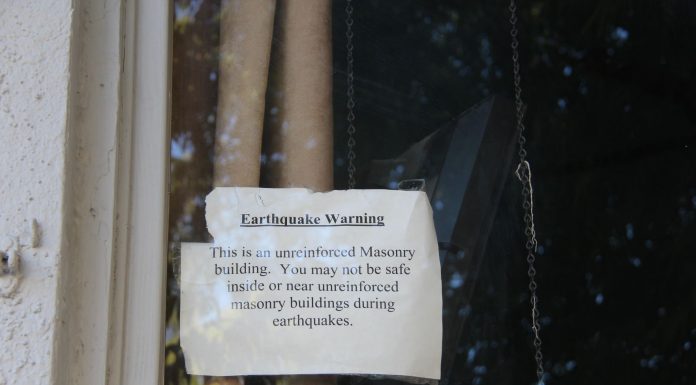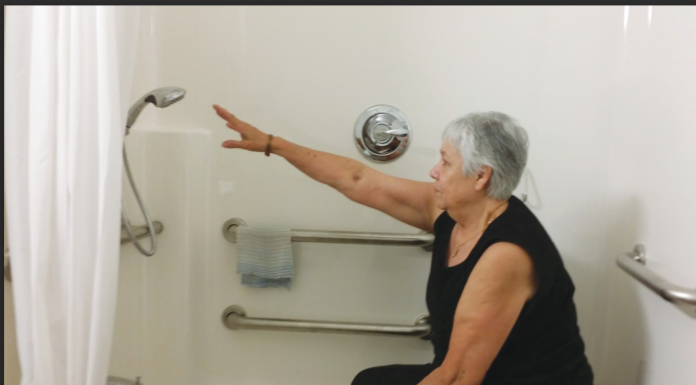Gilroy growth initiative qualifies for November ballot
Gilroy’s urban growth boundary (UGB) initiative has more than the required number of signatures needed to qualify for the November ballot.
City helps on unsafe buildings
In a move that has been lauded by downtown property owners and the association that represents downtown businesses, the city’s stance on unreinforced masonry (URM) buildings is about to get a little more flexible.“The city’s goal is to get all [of the URM buildings] under compliance so that we can move forward, get them all occupied, and downtown hopping,” said Susan Ostrander, interim development services manager.“We are starting to get more interest in downtown,” she continued. “A sign of the economy in turnaround.”Currently, there are 15 URM buildings downtown, she said, all at different stages of compliance with the city’s current URM ordinance to ensure earthquake safety.“Some have never been occupied, some have been vacated. Some are working on planning permits toward getting their facades done, while others have completed the planning stage and entered in the building permit stages for retrofit work,” she said.At its last meeting, the City Council moved forward with staff recommendations to make the city’s URM ordinance easier for downtown property owners to comply with, in order to make the necessary upgrades to their buildings while ensuring public safety.The state’s URM building law requires local jurisdictions such as Gilroy to inventory all potentially hazardous buildings and establish a local program to mitigate the hazards. In 2006, Gilroy amended its URM ordinance to require one of two levels of mitigation: a “mandatory” minimum retrofit or a “voluntary” full retrofit.What turned out to be contentious, and according to Ostrander’s staff report, “counterproductive,” was a rule in the ordinance that mandated a URM building that has been vacant for 24 hours remain unoccupied until a minimum or full retrofit is completed.“The 24-hour requirement has resulted in high vacancies among the URM buildings,” according to the report presented to the council.Ostrander, working with concerns presented at recent URM Task Force meetings, suggested changing the 24-hour time period to 120 days continuous vacancy before the retrofit requirement kicked in. Staff also recommended the city accept bonds at 100 percent for URM retrofit activities, instead of the standard 200 percent.Most important, the amended ordinance gives city building officials discretion in issuing a temporary certificate of occupancy to eligible vacant URM buildings prior to the building being retrofitted.“We wanted the ability to—in certain circumstances when health and safety is not at risk—allow temporary occupancy during retrofitting,” said Ostrander. “Buildings that have been vacant for a long time are losing rental income and can’t pay for a retrofit—there is no winning in that situation.”Gary Walton, downtown property owner and member of various URM committees over the years said it was “unfortunate” it took the city 10 years to get back to what state law required.“No other city in the state prohibits tenants from occupying a URM building after 24 hours being empty,” he said, adding that he understood the city’s original intent was to get the repairs done, but the strict timeframe and the inability of owners to occupy their buildings while retrofitting, was a high barrier to those who didn’t have the ready capital to make the required changes.“You have to be reasonable,” he said.None of Walton’s downtown holdings are URM buildings.“Ten years of non-economic activity can mean up to $1 million in lost revenue,” said Jose Montes, owner of four buildings downtown, including the old Dick Bruhn’s location—home of the soon-to-open used bookstore, BookBuyers.“So technically you already lost your building since you’ve lost more in rent than what your building is worth. And you are still paying property taxes and insurance. Not to mention the cost of damages to the [now vacant] building and penalties.”The city has come a long way since an earlier version of the ordinance placed a $60,000 fine on each URM building out of compliance.“Back then we had 25 URM buildings downtown and you could either pay the fine or tear down the building for $45,000,” recalled Walton. “It would have torn out the heart of downtown. So they brought down the fee to $15,000.”That was in 2011, the last time the ordinance was amended. Less than a year ago, the city was issuing arrest warrants to out-of-town URM property owners for non-compliance.The tough tactic, spurred by former mayor Don Gage, left some rancour between downtown property owners, local lawmakers and city staff, especially when it turned out official letters from the city never got to the property owners in question.“We’ve been making progress in bringing owners to the table over the last three years,” said Walton, who also serves on the board of the Downtown Business Association, which sent a letter of support to the city regarding the ordinance amendments.“They didn’t understand the difficulty they created by removing the stream of income property owners could have used to make improvements.”Walton added: “There are some things they did right and others they did wrong, but it’s done. You can’t change the past, only change the future, and this is a good first step in doing something positive.”For his part, Montes is excited about the changes.“I see new staff, a new City Council and mayor, a new city administrator and they all realize that new steps needed to take place before we got downtown going again,” he said.The first reading of the amended URM ordinance will take place at the next City Council meeting on Monday, June 20.
Gilroy Getting a Tourist-Worthy Book Shop
A Clinton is running for President and Donald Trump is all over the media headlines, in this crazy world where old is new again, the ’90s are back, and downtown Gilroy is getting a bookstore.
Transportation Tax Goes on the Ballot
After nearly two years of reaching out to local municipalities and compiling a laundry list of transportation issues throughout the county, the 12-member VTA board voted unanimously to place a 30-year, countywide half-cent sales tax measure on the November ballot.
ADA Remodel Made Access Worse, Tenants Say
Remodeling at a Gilroy low-income housing complex has left apartments with bathrooms inaccessible to handicapped residents, a violation of federal law according to one man.A city inspector signed off on upgrades at the Plum Tree West apartments on Montebello Drive, but the work does not comply with the Americans With Disabilities Act (ADA) designed to ensure access indoors and outside for the handicapped, resident Tim Holliday alleged.Holliday, 41, has been wheelchair bound for 30 years because of an affliction that causes spasms that paralyze his legs.“They took away the showers and put in bathtubs and they put plates over emergency buttons so we can no longer use them,” Holliday said.“A young man in a wheelchair fell down in his tub and now he uses a neighbor’s shower, another man is 94,” said Sally Armendariz of the Community Agency for Resources, Advocacy and Services, or CARAS, the Gilroy nonprofit assisting complex residents, some of whom have live-in caregivers.At least 15 residents whose apartments have been remodeled so far in the 70-unit complex met last week to compare notes, which mostly concern bathrooms but include other complaints, such as access to stoves.Violet Guliza is 90. She has severe arthritis in her legs and needs a walker to get around. Before the remodel, her one-bedroom, one-bathroom unit had a walk-in shower that made getting in and out easy despite her disability, she said.But showers were replaced by tubs with shower heads and Guliza cannot lift her legs high enough to step over and into the tub, she said.“I can’t even understand why they remodeled it,” Guliza said, noting her apartment was in good condition before the work.Residents were given checks for hotels and meals then moved out of their units during the initial two-week project, according to Holliday and Guliza. They stayed with relatives.Their units were remodeled in early May and others are under construction now, they said.At Gilroy City Hall, community development director Kristi Abrams said the city “absolutely” will revisit the apartment if residents request a re-inspection. She said none of the residents have called her about the issue.However, she said, “There is no code requirement that the city can enforce so the units are accessible. We have no legal remedy, the code has no requirement for all units to be accessible in any type of complex.”She said the city inspector who approved the remodels is its specialist on such matters, although she said he still is working at getting official certification as an access specialist.The complex is for income-qualified people age 62 and over. It’s insured and operated under rules administered by the U.S. Department of Housing and Urban Development (HUD) and is owned by Preservation Partners Management Group Inc. of Torrance, California.That development group specializes in the acquisition, rehabilitation and preservation of HUD and California Housing Finance Agency insured and assisted affordable housing developments, according to its website.“PPD provides the opportunity to rehabilitate and permanently preserve existing affordable housing assets by offering owners the opportunity to realize ‘market values’ upon sale. Since our formation in 1999, we have utilized low-income housing tax credits and tax-exempt bond financings to acquire and rehabilitate 29 properties representing 3,130 rental units in Washington, Virginia and throughout California,” the website reads.The firm did not return calls requesting comment on complaints by the Plum Tree West residents.To support his contention that the newly installed features do not comply with federal law, Holliday cited a top federal law enforcement agency on the matter of bathtub controls.“I found a 2010 ADA Standards for Accessible Design from the Department of Justice,” he wrote in an email. “According to section 607.5 it reads: ‘Controls, other than drain stoppers, shall be located on an end wall. Controls shall be between the bathtub rim and grab bar, and between the open side of the bathtub and the centerline of the width of the bathtub.”The newly installed tubs all have control knobs on the far back wall. They are unreachable by people with disabilities, according to Holliday and Guliza.Other problems involve shower heads that are mounted just over four feet off the floor, which Holliday says is too low; inaccessible garbage disposals and ovens whose design make it impossible for him to reach the racks from his wheelchair when the door is open.Abrams said she wants to review the Justice Department citation. She cautioned that such sections cannot be taken out of context and have to be considered along with other parts of the law.“I’m not saying it’s right or wrong. We cannot just take little abstract out, we have to look at the whole (ADA),” she said.
Gilroy Police Check You Out ‘Next Door’
Email is for work, Facebook is where you find out about local events and Instagram is where you go to learn about new products by millennial brand ambassadors.
Measure E School Bond Wins
The Gilroy Unified School District will receive $170 million from city property owners to build a new elementary school and update two middle schools.
Do new schools matter?
In mailers to thousands to Gilroy homes, in speeches, in endorsements by politicians and wealthy businessmen and on signs all around town, voters have been told that passage of the $170 million Measure E bond proposal on Tuesday’s ballot will ensure Gilroy kids get a good education by building modern schools with state-of-the-art technology.But a Dispatch review of school rankings and research data suggest the jury is still out on whether new facilities make a significant difference in some measures of academic standards.In Gilroy, school rankings appear inconsistent on the question and suggest that factors such as poverty play a bigger role than facilities when it comes to classroom achievement.Christopher High School, the district’s $158 million showcase, was built with 2008 bond money and non-voter approved $33 million in Certificates of Participation, repaid from the general fund. Its state academic ratings are high, 8 out of 10 compared to all California high schools and 7 among schools with similar demographics.But Gilroy High School, an old facility with some recent modernization, ranks at 4 among all high schools and 5 among similar schools in the state.Glen View Elementary School was completely remodeled last year with about $7 million from 2008’s $150 million Measure P, money still being repaid by taxpayers.Glen View in the past has lagged in test scores and in recent tests that pattern continues. The school ranked 4 on a scale of 1 to 10 compared to schools statewide.Compared to schools with similar demographics it ranked 3. And in terms of how it serves low-income students, who make up most of its student body, it also ranked at 3.Gilroy Prep School, the only charter school in the Gilroy Unified School District, ranked at 10 among California schools, 9 in how it helps low-income kids and 6 compared to similar schools.At GPS, technology of the kind Measure E would pay for helps students. Personal computers allow students to interact immediately with teachers, and allow teachers to monitor in real time whether students understand what’s being taught.When it opened in 2011, GPS was put in a collection of old portables at South Valley Junior High School. And while the school has since had some upgrades paid for by bond money, its scores from the beginning have been among the state’s highest.GUSD officials, including assistant superintendent Alvaro Mesa, have said comparisons with a charter school aren’t fair and that differences between schools such as Glen View and Gilroy Prep have more to do with the percentage of low-income students than facility conditions.GPS has always focused on low-income, underserved families, with school officials sometimes knocking on doors in low-income neighborhoods to recruit students.About 55 percent of GPS students are on a free and reduced cost lunch program, an indication of those families’ low-income.The figure at Glen View is a lot higher, Meza said.Asked to comment on whether spending millions on school facilities and really matters in classroom achievement, schools superintendent Debbie Flores issued this statement:“The district has not stated that Measure E is needed to improve education, but rather to help maintain the high-quality of education currently provided to all local students. If Measure E does not pass, additional monies from the general fund would need to go to shoring up our older facilities and ensuring they continue to meet safety standards for students. This would take needed funds away from educational programs. Also, the district believes that equitable facilities should be provided to all students.”In the newest Yes on E mailer, Gilroy businessman and Chamber of Commerce 2016 Man of the Year for 2016 Joel Goldsmith put it this way: “Nothing in our community is more important than educating our young people, and that is best done in modern facilities.”Mayor Perry Woodward wrote in the mailing that passage “will help sustain the high quality of education provided to our children and allow us to modernize and build facilities to better support instruction needs.”When it comes to Gilroy’s oldest—South Valley and Brownell—and its newest—Solorsano—middle schools there is almost no difference in their state rankings.Here’s now the rankings show up on greatschools.org, which tracks state school standings nationwide.Brownell and Solorsano ranked 7 and South Valley 6 when compared to all California middle schools.Compared to middle schools with similar demographics, Brownell outranked Solorsano, 7 to 6, and South Valley was at 5.Compared to how well the schools meet the needs of low-income students, Solorsano ranked 6 while the others had 5.At the California Policy Center, a think-tank that digs into school bonding, researcher and author Kevin Dayton said Tuesday, “I am not aware of any peer-reviewed study, or any study for that matter, that has proven that a bond measure and facilities improvement results in better test scores. To think that a new building is going to make children be better mathematicians or thinkers is absurd.”However, in a 2010 study the 21st Century School Foundation (at http://bit.ly/24jfAVL) in Washington D.C. found that “Recent research continues to point to a small but steadily positive relationship between the quality of a public school facility and a range of academic and community outcomes.”Among its cited research one study found that, “In schools with poor facilities, students attended less days on average and therefore had lower grades in English Language Arts and Math standardized tests. Attendance was found to be a full mediator for grades in ELA and a partial mediator for grades in math.”Another cited study found a “4-9 percent difference between students in schools in worst/best condition; 5-9 percent difference between students in oldest/newest schools; 4 percent difference in graduation rates between students in schools in worst/best condition and between students in oldest/newest schools.”Dayton is critical of the political processes behind school bond sales.“At every stage of the process, interests that will benefit from bond sales can take advantage of a system that favors passage of a bond measure,” he wrote in 2015. “Some issues of concern include use of public funds to develop campaigns to pass bond measures, significant political contributions to campaigns from interests likely to benefit from construction, involvement of college foundations as intermediaries for campaign contributions, and conflicts of interest and alleged pay-to-play contracts.”He went on, “Few Californians realize how much debt they’ve imposed on future generations with their votes for bond measures meant to fund the construction of new and modernized school facilities.“From 2001 to 2014, California voters considered 1147 ballot measures proposed by K-12 school districts and community college districts to borrow money for construction via bond sales. Voters approved 911 of these bond measures, giving 642 school and college districts authority to borrow a total of $110.4 billion.”Dayton’s study can be found here: http://bit.ly/1TY7qAC.In its latest round of campaign finance disclosures, the Yes on E group, Friends of GUSD Supporting Measure E, listed more contributions from companies outside Gilroy that do business with the school district.They include Val’s Plumbing & Heating of Salinas, $2,500; Total Securities Concepts Division of TSCS, Inc., of Prunedale, $2,500; and Palace Business Solutions of Santa Cruz, $500.Those are in addition to more than $30,000 in contributions already received from a half-dozen of the school district’s biggest contractors, some of whom have worked on previous bond projects, including the Seward L. Schreder Construction of Redding. That firm did more than $14 million in bond-related projects with GUSD from 2011 through 2015 and is Measure E’s biggest financial supporter at $10,000.In its campaign filing report, the pro-E committee listed spending of $2,107 for 400 yard signs and $5,753 to print and mail flyers to 10,000 Gilroy homes.It also lists a $2,279 reimbursed to Jaime Rosso for money he spent out of his own pocket for campaign literature, banners and sign lumber before the committee had its own account, he said. Rosso is the spokesperson for the committee and a longtime GUSD school board member.
Editorial: Yes on Measure E
If you want to make America great again, there’s something you can do right away: Vote yes on Measure E and support Gilroy’s schools.With one swoop of your pen and a serious commitment of $60 for every $100,000 of property you own, you can build a new elementary school and fix up degrading middle schools. You can keep all of the district’s schools top notch, which is what we think makes America and our community great.For some reasons that make no sense to us, schools, teachers and taxes have become anathema in this country over the past 40 years. Everyone wants the best services but no one wants to pay for them.If you go back to a time a lot of people think America was great (and we think it’s still great, by the way), you might try the 1950s and 1960s when tax rates, particularly on the rich, were double and triple what they are now. Under Dwight D. Eisenhower, the rich paid 91 percent of their income. Under Richard M. Nixon, it was down to 77 percent. But then it kept dropping as rich people gained more power and convinced a large number of Americans that taxes were bad, particularly taxes on the rich. Back then, people didn’t mind the taxes as much because they knew they were making America great. They were proud of their country and still incredibly rich, despite the taxes.The earlier tax rates afforded us immeasurable greatness. We built a transcontinental highway system. We built the biggest buildings in the world. We went to the moon. We built great schools and free public university systems.But now schools have to raise money by holding their hats out like beggars. What’s happened to this country, where no one asks us to vote to spend trillions on wars both parties later realize were mistakes, but we act like the schools are criminals for wanting to give teachers a living wage and give kids modern buildings and educational systems?How do so many people--some of them wealthier people who send their children to private schools-- figure taxes to help schools are a bad thing? There are exceptions, like Don Christopher, a businessman who puts his funds where his heart is. We aren’t saying the schools and their administrators are perfect. We’ve spent plenty of time dissecting their faults, poring over every document. We aren’t happy about some of the lack of transparency we’ve seen. We don’t like that they don’t live-stream school board meetings. We don’t like how they rushed this election without time to make a stronger case and can’t or won’t even name who solicited the highest donations. The list of projects the money will be spent on is not detailed enough. We question some of the ties between contractors and the board. We don’t like the fact that Christopher High School came in so over budget that its promised theater was never built, the track and field needed private funding to be completed and seven years after the building was finished, it needs repairs.But after putting them through the investigative wringer, we see no reason not to put up another $170 million to keep our schools on the cutting edge. (For comparison’s sake, the Iraq War cost $720 million a day.) The bottom line is that we have to support our schools, whatever it takes. To do anything less is criminal. It’s the opposite of making America great.In Finland and China teachers are as valued as doctors and CEOs. Those countries haven’t forgotten the value of great education. Rather than criticizing teachers unions we’d like to see the schools pay the way private companies do. That would guarantee the best and the brightest get the jobs and hold them.If you want to look at just the bottom line: this isn’t so much a tax as it is an investment. Nothing will make property value go up more than a great school system. Gilroy homes are already a bargain in Silicon Valley. Add more school buildings like Christopher High and more programs like Gilroy High’s biomedical training, and watch the values increase far more than the taxes.


















